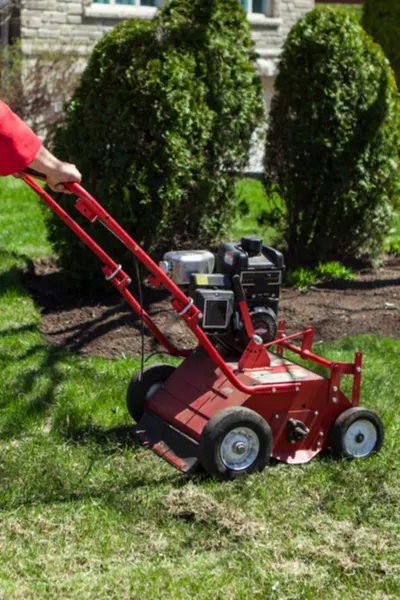When it comes to fall lawn chores that can help propel lawns to healthier, lush growth next year, it’s hard to beat aerating!
Aerating is one of the most over-looked tasks when it comes to overall lawn care. And yet, it helps solve so many of the problems and issues that plague lawns every year.
Why Aereate
Aerating is the process of puncturing the soil below to create open pockets. Why is that so important? It is through these pockets that air, water, and nutrients find their way to feed the roots of grass.

Over time, the soil of lawns compact from foot traffic, mowers, and other general use. And as this compaction occurs, it keeps all of the valuable life giving minerals and nutrients from getting through to the roots.
Rains simply wash away, as do any type of fertilizing, seeding or watering efforts. But by opening up the soil, your lawn can once again breathe and come alive!
How & When To Aerate
The best time to aerate a lawn is in the fall or early spring. These are both periods where the lawn is softer, and not in full-growth mode.

Not only does it make it easier to perform, these more dormant periods are great for allowing the lawn time to recover from the process.
Attempting to aerate in the summer months can make it hard for the tines to break through the thicker lawn growth. And wintertime of course poses the obvious issues of frozen ground.
There are two basic types of aerators. One version slits the soil in place, while the other removes a small plug of soil. The plug version will either deposit the soil on top of the lawn, or collect it in a bin.

Both the slit and plug options work well in opening up the soil, although the plug method performs the task a bit more thoroughly.
Most local rental companies offer a wide selection for daily rental for the larger plug styles. Purchased models for Slit / Plug aerators can usually be found for pulling behind lawn tractors for around $150 to $200. (Product Link: Agrifab Tow Plug Aerator)
There are even shoe spike versions that can be worn while walking or mowing the lawn that open up air pockets.
After Aerating
After aerating, keep heavy traffic off of the lawn for a few days. This allows for the plugs to break down naturally, and not be compressed by foot traffic into the turf.
This is also the perfect time to add a little grass seed to your lawn by over seeding! New seed, broadcast over the surface of the soil settles down into the slits or holes made from aeration.
This seed has an easier time establishing in the soil in the voids left from the tines or plugs.

It is a good idea to wait at least a year before aerating new lawns to avoid damaging new turf. In addition, aerating when the soil is extremely moist is a big no-no. The process can actually create more harm than good by tearing the soil.
Here is to getting your yard in shape this fall by aerating, and to a great lawn next year! For more great autumn lawn tips, check out our article, 5 Fall Lawn Tips For A Better Lawn Next Year.

This Is My Garden is a website dedicated to spreading the love and knowledge of gardening around the world. We publish two new garden articles each week. This article may contain affiliate links.

